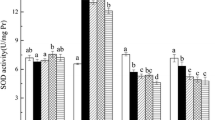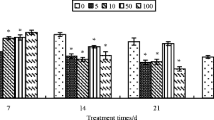Abstract
Lead (Pb) and decabromodiphenyl ether (BDE209) are the main contaminants at e-waste recycling sites, and their potential toxicological effects on terrestrial organisms have received extensive attention. However, the impacts on the oxidative perturbations and hydroxyl radical (·OH) generation in earthworms of exposure to the two chemicals remain almost unknown. Therefore, indoor incubation tests were performed on control and contaminated soil samples to determine the effects of Pb in earthworms Eisenia fetida in the presence of BDE209 through the use of several biomarkers in microcosms. The results have demonstrated that the addition of BDE209 (1 or 10 mg kg−1) decreased the enzymatic activities [superoxide dismutase, catalase (CAT), peroxidase] and total antioxidant capacity (T-AOC) compared with exposure to BDE209 alone (50, 250 or 500 mg kg−1). Electron paramagnetic resonance spectra indicated that ·OH radicals in earthworms were significantly induced by Pb in the presence of BDE209. The changing pattern of malondialdehyde (MDA) contents was accordant with that of ·OH intensity suggested that reactive oxygen species might lead to cellular lipid peroxidation. Furthermore, CAT exhibited more sensitive response to single Pb exposure than the other biomarkers, while T-AOC, ·OH and MDA might be three most sensitive biomarkers in earthworms after simultaneous exposure to Pb and BDE209. The results of these observations suggested that oxidative stress appeared in E. fetida, and it may play an important role in inducing the Pb and BDE209 toxicity to earthworms.







Similar content being viewed by others

References
Aina R, Labra M, Fumagalli P, Vannini C, Marsoni M, Cucchi U, Bracale M, Sgorbati S, Citterio S (2007) Thiol-peptide level and proteomic changes in response to cadmium toxicity in Oryza sativa L. roots. Environ Exp Bot 59:381–392
Bao GH, Bi Y, Li YC, Kou ZH, Hu LG, Ge YH, Wang Y, Wang D (2014) Overproduction of reactive oxygen species involved in the pathogenicity of Fusarium in potato tubers. Physiol Mol Plant P 86:35–42
Bradford MM (1976) A rapid and sensitive method for the quantitation of microgram quantities of protein utilizing the principle of protein-dye binding. Anal Biochem 72:248–254
Catalá A (2009) Lipid peroxidation of membrane phospholipids generates hydroxy-alkenals and oxidized phospholipids active in physiological and/or pathological conditions. Chem Phys Lipids 157:1–11
Chen L (2014) Combined toxicological effect of decabromodiphenyl ether and lead pollution on Eisenia fetida. Master’s Thesis, East China University of Science and Technology, Shanghai, China, pp. 46–47
Di Giulio RT, Washburn PC, Wenning RJ, Winston GW, Jewell CS (1989) Biochemical responses in aquatic animals: a review of determinants of oxidative stress. Environ Toxicol Chem 8:1103–1123
Fatima RA, Ahmad M (2005) Certain antioxidant enzymes of Allium cepa as biomarkers for the detection of toxic heavy metals in wastewater. Sci Total Environ 346:256–273
Feng MB, Qu RJ, Wang C, Wang LS, Wang ZY (2013) Comparative antioxidant status in freshwater fish Carassius auratus exposed to six current-use brominated flame retardants: a combined experimental and theoretical study. Aquat Toxicol 140–141:314–323
International Standard Organization (ISO) (1998) Standard number No. 11268-2. Soil quality: effects of pollutants on earthworms (Eisenia fetida) Part II. Method for the determination of effects on reproduction, Geneva
Li M, Liu ZT, Xu Y, Cui YB, Li DS, Kong ZM (2009) Comparative effects of Cd and Pb on biochemical response and DNA damage in the earthworm Eisenia fetida (Annelida, Oligochaeta). Chemosphere 74:621–625
Lin RZ, Wang XR, Luo Y, Du WC, Guo HY, Yin DQ (2007) Effects of soil cadmium on growth, oxidative stress and antioxidant system in wheat seedlings (Triticum aestivum L.). Chemosphere 69:89–98
Liu CS, Yu K, Shi XJ, Wang JX, Lam PK, Wu RS (2007) Induction of oxidative stress and apoptosis by PFOS and PFOA in primary cultured hepatocytes of freshwater tilapia (Oreochromis niloticus). Aquat Toxicol 82:135–143
Liu Y, Zhou QX, Xie XJ, Lin DS, Dong LX (2010) Oxidative stress and DNA damage in the earthworm Eisenia fetida induced by toluene, ethylbenzene and xylene. Ecotoxicology 19:1551–1559
Liu S, Zhou QX, Wang YY (2011) Ecotoxicological responses of the earthworm Eisenia fetida exposed to soil contaminated with HHCB. Chemosphere 83:1080–1086
Liu S, Zhou QX, Chen C (2012) Antioxidant enzyme activities and lipid peroxidation in earthworm Eisenia fetida exposed to 1,3,4,6,7,8-hexahydro-4,6,6,7,8,8-hexamethyl-cyclopenta-γ-2-benzopyran. Environ Toxicol 27:472–479
Luo Y, Luo XJ, Lin Z, Chen SJ, Liu J, Mai BX (2009) Polybrominated diphenyl ethers in road and farmland soils from an e-waste recycling region in Southern China: concentrations, source profiles, and potential dispersion and deposition. Sci Total Environ 407:1105–1113
Miller DM, Aust SD (1989) Studies of ascorbate-dependent, iron-catalyzed lipid peroxidation. Arch Biochem Biophys 271:113–119
Mishra V, Mishra P, Srivastava G, Prasad SM (2011) Effect of dimethoate and UV-B irradiation on the response of antioxidant defense systems in cowpea (Vigna unguiculata L.) seedlings. Pestic Biochem Physiol 100:118–123
Organization for Economic Co-operation and Development (OECD) (2004) Test 207: earthworm, acute toxicity tests. In: OECD Guidelines for Testing of Chemicals, Paris
Saint-Denis M, Narbonne JF, Arnaud C, Ribera D (2001) Biochemical responses of the earthworm Eisenia fetida andrei exposed to contaminated artificial soil: effects of lead acetate. Soil Biol Biochem 33:395–404
Shang H, Wang P, Wang T, Wang Y, Zhang H, Fu J (2013) Bioaccumulation of PCDD/Fs, PCBs and PBDEs by earthworms in field soils of an E-waste dismantling area in China. Environ Int 54:50–58
Sun YY, Yu HG, Zhang JF, Yin Y, Shi HH, Wang XR (2006) Bioaccumulation, depuration and oxidative stress in fish Carassius auratus under phenanthrene exposure. Chemosphere 63:1319–1327
Takeshita K, Fujii K, Anzai K, Ozawa T (2004) In vivo monitoring of hydroxyl radical generation caused by X-ray irradiation of rats using the spin trapping/EPR technique. Free Radic Biol Med 36:1134–1143
Tang XJ, Shen CF, Shi DZ, Cheema SA, Khan MI, Zhang CK (2010) Heavy metal and persistent organic compound contamination in soil from Wenling: an emerging e-waste recycling city in Taizhou area, China. J Hazard Mater 173:653–660
Taylor AM, Maher WA (2014) Exposure-dose-response of Tellina deltoidalis to metal contaminated estuarine sediments 2. Lead spiked sediments. Comp Biochem Physiol Part C 159:52–61
Xie XC, Wu YX, Zhu MY, Zhang YK, Wang XR (2011) Hydroxyl radical generation and oxidative stress in earthworms (Eisenia fetida) exposed to decabromodiphenyl ether (BDE-209). Ecotoxicology 20:993–999
Xie XC, Qian Y, Wu YX, Yin Y, Zhai JP (2013) Effects of decabromodiphenyl ether (BDE-209) on the avoidance response, survival, growth and reproduction of earthworms (Eisenia fetida). Ecotoxicol Environ Saf 90:21–27
Xu DM, Li CD, Wen YZ, Liu WP (2013) Antioxidant defense system responses and DNA damage of earthworms exposed to perfluorooctane sulfonate (PFOS). Environ Pollut 174:121–127
Xue YG, Gu XY, Wang XR, Sun C, Xu XH, Sun J, Zhang BG (2009) The hydroxyl radical generation and oxidative stress for the earthworm Eisenia fetida exposed to tetrabromobisphenol A. Ecotoxicology 18:693–699
Yamakoshi Y, Umezawa N, Ryu A, Arakane K, Miyata N, Goda Y (2003) Active oxygen species generated from photoexcited fullerene (C60) as potential medicines: O ·−2 versus 1O2. J Am Chem Soc 125:12803–12809
Zhang W, Zhang M, An S, Xiong B, Li H, Cui CZ, Lin KF (2012) Ecotoxicological effects of decabromodiphenyl ether and cadmium contamination on soil microbes and enzymes. Ecotoxicol Environ Saf 82:71–79
Zhang BJ, Li XY, Chen DD, Wang JJ (2013a) Effects of 1-octyl-3-methylimidazolium bromide on the antioxidant system of Lemna minor. Protoplasma 250:103–110
Zhang QM, Zhu LS, Wang J, Xie H, Wang JH, Han YN, Yang JH (2013b) Oxidative stress and lipid peroxidation in the earthworm Eisenia fetida induced by low doses of fomesafen. Environ Sci Pollut Res 20:201–208
Zhang W, Liu K, Chen L, Chen L, Lin KF, Fu RB (2014) A multi-biomarker risk assessment of the impact of brominated flame retardant-decabromodiphenyl ether (BDE209) on the antioxidant system of earthworm Eisenia fetida. Environ Toxicol Pharmacol 38:297–304
Zhu J, Zhao ZY, Lu YT (2006) Evaluation of genotoxicity of combined soil pollution by cadmium and phenanthrene on earthworm. J Environ Sci 18:1210–1215
Zhu ZC, Chen SJ, Zheng J, Tian M, Feng AH, Luo XJ, Mai BX (2014) Occurrence of brominated flame retardants (BFRs), organochlorine pesticides (OCPs), and polychlorinated biphenyls (PCBs) in agricultural soils in a BFR-manufacturing region of North China. Sci Total Environ 481:47–54
Acknowledgments
This research was financially supported by the National Natural Science Foundation of China (41371467, 40901148), the National Environmental Protection Public Welfare Science and Technology Research Program of China (201409037, 201509060, 201309047, 201309030), the Major State Basic Research Development Program of China (2011CB200904), the Scientific Project on Treatment and Control of Water Pollution (2014ZX07104006).
Conflict of interest
The authors declare that there is no conflict of interest.
Author information
Authors and Affiliations
Corresponding author
Additional information
Lin Chen is Joint first author.
Rights and permissions
About this article
Cite this article
Liu, K., Chen, L., Zhang, W. et al. EPR detection of hydroxyl radical generation and oxidative perturbations in lead-exposed earthworms (Eisenia fetida) in the presence of decabromodiphenyl ether. Ecotoxicology 24, 301–308 (2015). https://doi.org/10.1007/s10646-014-1378-4
Accepted:
Published:
Issue Date:
DOI: https://doi.org/10.1007/s10646-014-1378-4



